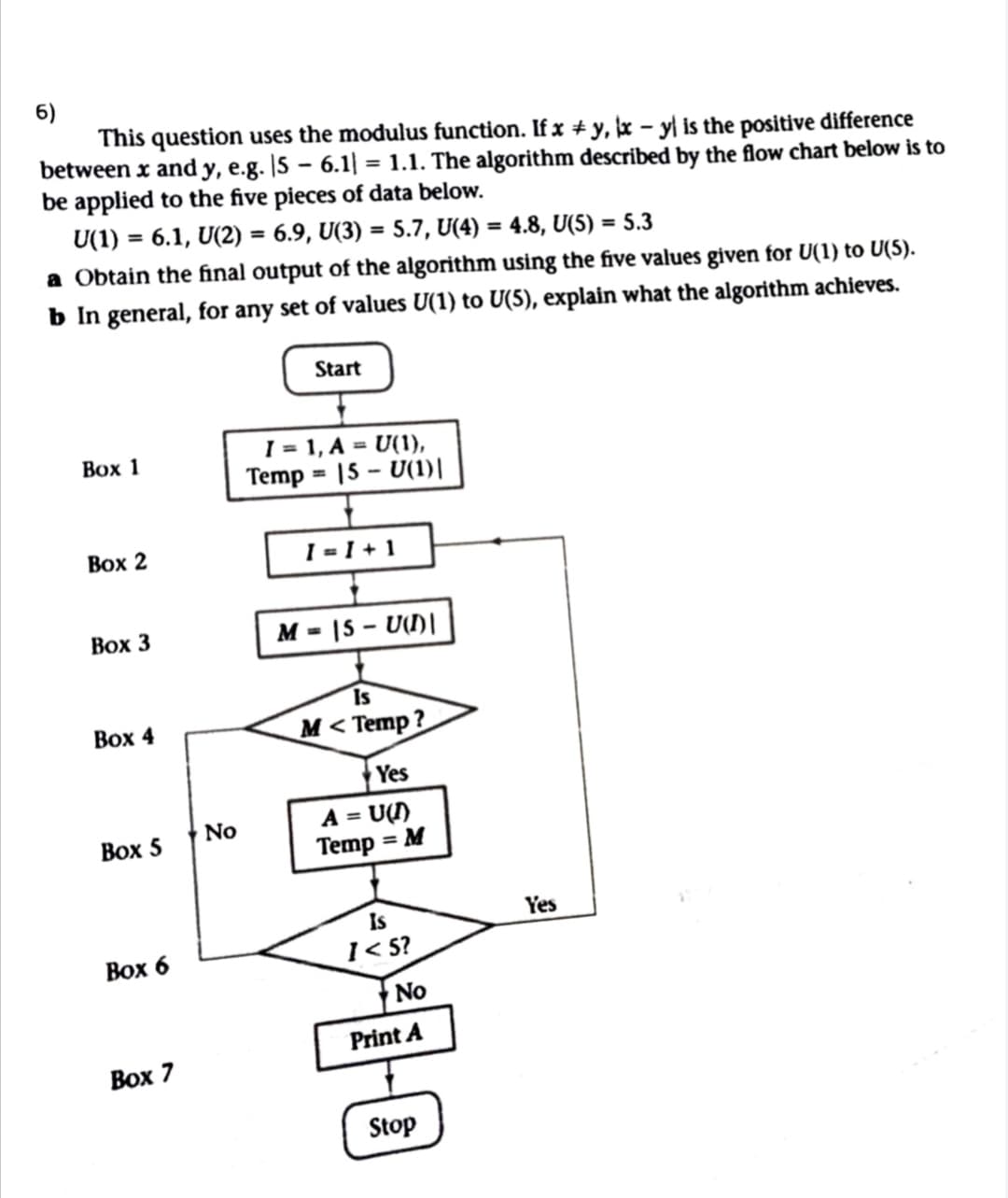6) This question uses the modulus function. If x + y, x – yl is the positive difference between x and y, e.g. |5 – 6.1| = 1.1. The algorithm described by the flow chart below is to be applied to the five pieces of data below. U(1) = 6.1, U(2) = 6.9, U(3) = 5.7, U(4) = 4.8, U(5) = 5.3 %3D %3D a Obtain the final output of the algorithm using the five values given for U(1) to U(5). b In general, for any set of values U(1) to U(5), explain what the algorithm achieves.
6) This question uses the modulus function. If x + y, x – yl is the positive difference between x and y, e.g. |5 – 6.1| = 1.1. The algorithm described by the flow chart below is to be applied to the five pieces of data below. U(1) = 6.1, U(2) = 6.9, U(3) = 5.7, U(4) = 4.8, U(5) = 5.3 %3D %3D a Obtain the final output of the algorithm using the five values given for U(1) to U(5). b In general, for any set of values U(1) to U(5), explain what the algorithm achieves.
Computer Networking: A Top-Down Approach (7th Edition)
7th Edition
ISBN:9780133594140
Author:James Kurose, Keith Ross
Publisher:James Kurose, Keith Ross
Chapter1: Computer Networks And The Internet
Section: Chapter Questions
Problem R1RQ: What is the difference between a host and an end system? List several different types of end...
Related questions
Question

Transcribed Image Text:6)
This question uses the modulus function. If x + y, \x – yl is the positive difference
between x and y, e.g. |5 – 6.1| = 1.1. The algorithm described by the flow chart below is to
be applied to the five pieces of data below.
U(1) = 6.1, U(2) = 6.9, U(3) = 5.7, U(4) = 4.8, U(5) = 5.3
%3D
a Obtain the final output of the algorithm using the five values given for U(1) to U(S).
b In general, for any set of values U(1) to U(5), explain what the algorithm achieves.
Start
I = 1, A = U(1),
Temp = 15 - U(1)|
Box 1
Вох 2
I = 1 + 1
Вох 3
M = |S – U()|
Is
Вох 4
M< Temp ?
Yes
A = U()
Temp = M
%3D
No
Воx 5
Is
Yes
Вох 6
I< 5?
No
Print A
Вох 7
Stop
Expert Solution
This question has been solved!
Explore an expertly crafted, step-by-step solution for a thorough understanding of key concepts.
Step by step
Solved in 3 steps

Recommended textbooks for you

Computer Networking: A Top-Down Approach (7th Edi…
Computer Engineering
ISBN:
9780133594140
Author:
James Kurose, Keith Ross
Publisher:
PEARSON

Computer Organization and Design MIPS Edition, Fi…
Computer Engineering
ISBN:
9780124077263
Author:
David A. Patterson, John L. Hennessy
Publisher:
Elsevier Science

Network+ Guide to Networks (MindTap Course List)
Computer Engineering
ISBN:
9781337569330
Author:
Jill West, Tamara Dean, Jean Andrews
Publisher:
Cengage Learning

Computer Networking: A Top-Down Approach (7th Edi…
Computer Engineering
ISBN:
9780133594140
Author:
James Kurose, Keith Ross
Publisher:
PEARSON

Computer Organization and Design MIPS Edition, Fi…
Computer Engineering
ISBN:
9780124077263
Author:
David A. Patterson, John L. Hennessy
Publisher:
Elsevier Science

Network+ Guide to Networks (MindTap Course List)
Computer Engineering
ISBN:
9781337569330
Author:
Jill West, Tamara Dean, Jean Andrews
Publisher:
Cengage Learning

Concepts of Database Management
Computer Engineering
ISBN:
9781337093422
Author:
Joy L. Starks, Philip J. Pratt, Mary Z. Last
Publisher:
Cengage Learning

Prelude to Programming
Computer Engineering
ISBN:
9780133750423
Author:
VENIT, Stewart
Publisher:
Pearson Education

Sc Business Data Communications and Networking, T…
Computer Engineering
ISBN:
9781119368830
Author:
FITZGERALD
Publisher:
WILEY